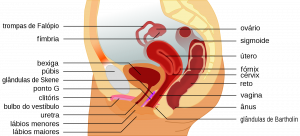Let’s talk a little about female anatomy! The female genitalia consists of several internal and external parts1. Internally, it is made up of two ovaries, two fallopian tubes (fallopian tubes), and the uterus. Externally, the vagina connects the internal female organs with the external part, which is the vulva. The vulva, in turn, is made up of large and small labia (folds that serve as protection for the vagina) and the clitoris. On each side of the vagina are the accessory glands responsible for vaginal lubrication, mainly during sexual intercourse, which are called Bartholin’s glands2.
All this detailed explanation about the female genitalia is necessary so we can understand how it works and discuss a little-known issue that can alarm any woman when diagnosed: Bartholin’s cysts.
What Are Bartholin’s Cysts?
Bartholin’s cysts3 are the blockage of the ducts of the Bartholin’s glands, which are two glands located on each side of the vagina.
Usually, a Bartholin’s cyst is completely painless and shows no symptoms to indicate its presence. It can even resolve on its own, often going unnoticed. However, when fluid accumulates, an infection can cause redness and considerable discomfort in the area, in addition to swelling and possible discharge of pus.
Causes of Bartholin’s Cysts
Bartholin’s cysts can affect any woman at any age, but they occur more frequently in sexually active women. The cysts develop due to the accumulation of vaginal lubricant liquid produced by the gland, which creates the possibility for bacteria to accumulate in the area, resulting in bartholinitis.
This infection at the site of Bartholin’s cysts can occur during unprotected sexual intercourse (without condoms), due to the risk of infection with bacteria such as Chlamydia trachomatis or Neisseria gonorrhoeae, among others that can cause infection along with inflammation.
Besides the risks from unprotected sex, this condition can also occur due to poor intimate hygiene habits, such as improper washing of the female genitalia or contact of bacteria from the intestinal tract with the Bartholin’s glands. Therefore, adequate hygiene (excessive hygiene can also be harmful) and practicing sex with condom use are the best ways to protect yourself and reduce the risk of developing a Bartholin’s cyst.
Symptoms of Bartholin’s Cyst
Bartholin’s cyst typically does not cause symptoms and it is not contagious. But if palpated, it can be felt with the fingertips as a kind of lump or internal bump. Symptoms of a possible infection in the cyst include:
- Red and warm area;
- Swelling of the area;
- Pus discharge;
- Appearance of a boil;
- Fever
Other reported symptoms include difficulty sitting and walking, as well as discomfort during sexual intercourse. In more advanced cases, lumps have been observed very close to the vaginal opening. If you notice any of these symptoms, or even if you suspect it is a boil, seek immediate medical attention or visit your gynecologist for evaluation.
Does Bartholin’s Cyst Pose Risks During Pregnancy?
During pregnancy, developing a Bartholin’s cyst is usually not a serious concern. Firstly, because in most cases it resolves naturally without symptoms or major discomfort. Furthermore, it is not harmful to the woman or to the baby during normal delivery.
However, if the Bartholin’s cyst becomes infected during pregnancy, it is extremely important to see your obstetrician for evaluation so that they can identify the best treatment to combat the bacteria without posing risks to the mother or the baby’s development.
Treatment of Bartholin’s Cyst
The best treatment for a Bartholin’s cyst should be evaluated and prescribed by your gynecologist. Normally, treatment involves anti-inflammatory medications and painkillers to reduce discomfort and symptoms. In more specific cases where there is infection and pus, antibiotics may be prescribed for a stronger and more effective action.
Sitz baths with warm to hot water may also be recommended to relieve swelling and help eliminate pus from inside the Bartholin’s cyst. In more complex cases, surgical removal of the Bartholin’s cyst or draining of the cyst fluid may be recommended, or even removal of the Bartholin’s glands if none of the initial treatments have given satisfactory results. That is why a thorough assessment by the gynecologist is necessary, as each case is unique and the best treatment must be chosen accordingly.
A sitz bath is one of the best natural tips to relieve symptoms and assist with treatment. It should be done with water at a warm to hot temperature (up to 35⁰C) for at least 15 minutes, preferably three to four times a day. In this way, the glands are able to relax, which allows the liquid inside to be naturally released, reducing swelling and discomfort.
Along with the water for the sitz bath, some medicinal herbs may be used to help relieve symptoms and act as a kind of pain reliever. The bark of barbatimão, along with aroeira bark, for example, promise immediate relief from local discomfort and swelling.












